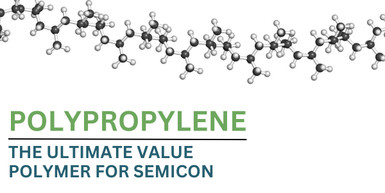Polypropylene The Ultimate Value Polymer
Polypropylene is the 2nd ranked resin globally by volume with over 175 billion pounds produced each year. Polypropylene (aka PP) is known for its low-cost providing solutions ranging from packaging and fibers to automotive parts such as bumpers and interior components.
PP is generally known for good chemical resistivity, low density, excellent recyclability, low moisture, and fatigue resistance. PP is not necessarily known for its dimensional stability and is considered a general-purpose commodity substrate.
However, PP is used quite extensively in the Semiconductor industry including but not limited to applications in Wet Process chambers, wet benches, chemical tanks, and structural materials. PP is available either as a homopolymer or a copolymer.
As for Semiconductor usage, PP is used as a virgin resin, typically a homopolymer or as a copolymer with a flame-retardant additive to achieve enhanced FR capabilities such as UL-94 VO or even FM 4910 compliance. Let’s a deeper look at each of the variations and the impact on usage within semiconductors. For this article, we left off the discussion of stereoregular structures but will cover them in the future.
HOMOPOLYMER UNFILLED SUBSTATE
Homopolymer polypropylene is a semitransparent resin synthesized from a single propylene monomer without any ethylene monomers in the molecular chain. This leads to high regularity and consequently, a high level of crystallinity. Propylene homopolymer has a high strength-to-weight ratio and is stiffer and stronger than copolymer. These properties combined with good chemical resistance and weldability make it a material of choice in many corrosion-resistant structures such as chemical tanks, wet benches, and drip trays.
Homopolymer PP is available as either nucleated or non-nucleated. By using a nucleating agent, the crystallization rate is increased resulting in faster processing time. However, when using PP in wafer area applications, often non-nucleated PP is desired for purity in such applications as chamber Housings for Wet Process.
COPOLYMER POLYPROPYLENE
Copolymer PP comes in two basic structures and is different from homopolymer PP in that it blends ethene monomer into the propene chain. Random copolymer PP uses up to 6% ethene content on the chain, resulting in a flexible PP that is optically clear. Block copolymer PP uses 7-15% ethene content arranged in regular patterns, making a tough and less brittle PP.
Block copolymer PP is milky white. Block Copolymer PP is used as a base resin for most FR polypropylene materials as the increased impact is required to maintain acceptable properties due to the high load of flame-retardant additives used to meet compliance. FM4910-compliant PPs can have upward of 30% filler to meet compliance, which, of course, affects purity and leaching.
CONTACT YOUR LOCAL PORT PLASTICS SALES OFFICE FOR EVERYTHING SEMICONDUCTOR AND PLASTICS!
#SemiconScott
|
Download As PDF |
| Polypropylene The Ultimate Value Polymer |


